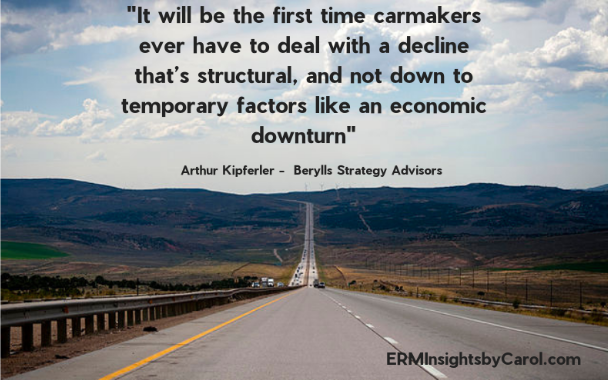On occasion, I come across news articles that present a great opportunity to showcase how ERM can be a valuable tool in helping organizations adapt to change. Because let’s face it – any organization, be it for-profit or non-profit, must adapt to growing trends to ensure they remain relevant for the long haul.
The best example I can think of off the top of my head is the story of Eastman-Kodak…
If you’re over the age of 30, you should know this iconic brand pretty well and be familiar with their famous disposable cameras and rolls of film. (Goodness knows I used enough of them growing up!) However, by not proactively identifying and managing major threats to its business objectives in a comprehensive way, Kodak eventually folded because of its inability to seize the opportunities related to the meteoric rise of digital photography and smartphones.
A story I recently caught in Bloomberg is another example of how organizations will need to “grab the bull by the horns” if they are to remain relevant in the decades ahead.
The story, ‘Peak Car’ and the End of an Industry, discusses a long-term trend in Germany and even parts of the U.S. where younger people are foregoing car ownership. Instead of owning a vehicle that sits idle most of the time, more and more people are opting to use services like Uber, car-sharing, and public transit to get around.
To illustrate what’s motivating this shift in mobility, Martin Bruesch, a 32-year old human resources executive, explains “If I’m truly honest with myself, then owning a car is too expensive with all these alternatives around.” He pays about 8.5 euros to use a service called CleverShuttle to get to work each day, which is around half the price of a taxi and less than what a garage charges for parking. Martin likes the fact that it’s cheap, he doesn’t have to search for a parking spot, and it’s environmentally friendly.
The decline in driving is much more profound for teens…
According to a study from the University of Michigan Transportation Research Institute, the number of 16-year-olds who had a driver’s license in 2014 was 47% lower than it was in 1983. Personally, my husband and I were aghast at that statistic, since getting a driver’s license was priority #1 when we each turned 16. While not as significant, all age groups except the over 55 crowd have seen declines in the numbers of individuals with a driver’s license.
An earlier study surveying young adults (ages 18-39) set out to understand what is motivating the millennial generation to eschew a driver’s license. The three top reasons include:
- Too busy or not enough time to get a driver’s license (37%)
- Owning and maintaining a vehicle is too expensive (32%)
- Able to get transportation from others (31%)
Although I can’t tell it personally judging from the traffic in my hometown of Tallahassee, Florida, other studies seem to suggest that driving in general has peaked in the U.S. Between 2004 and 2013, the total distance driven per person dropped by 9%.
While there isn’t any hard data to confirm this, reasons for the general decline in travel could include:
- Increasing numbers of work-from-home professionals
- The rise of Amazon and other e-retailers
- Endless entertainment options through the Internet
- More robust food delivery options like Uber Eats
Analyzing data from the U.S., Munich-based consulting firm Berylls Strategy Advisors predicts that total car sales will fall by 12% to 15.1 million vehicles by 2030.
How ERM may be able to help the auto industry (…and any organization) adjust to a new reality…
At its core, the goal of enterprise risk management is to identify both risks and opportunities to achieving strategic objectives, so that executives can make decisions to manage some risks and pursue some opportunities. Much of the time, it involved looking at past and present events to identify where the organization should focus its efforts.
While the article was focused on the auto industry, these types of phenomena are happening in other industries too. In another article, I discuss how many well-known food brands in the U.S. are scrambling because of changes in people’s dietary choices.
The reality is that organizations in any industry must look to the future to truly understand what may affect it both positively and negatively.
While it would be nice to have a crystal ball to know exactly what will happen in the future, evaluating trends is the next best thing. From these trends, the organization has a couple options.
Leading Indicators
Leading indicators can be used to project the impact a particular trend will have on achieving future objectives – is it a threat to our current strategy, or does a particular trend present an opportunity that we should seize?
Examples of leading indicators can include things I’ve mentioned above like number of new driver’s licenses being issued, uptake with alternative transportation options like Uber or public transit, fuel consumption (maybe), or any data on how people are spending their vacation time (i.e. road travel vs. air travel vs. staycation).
Scenario Analysis
Look at these trends and develop a few scenarios. Gather a cross-functional group to discuss how those scenarios could play out for the organization. What actions should be taken to hedge against extremely negative impacts and protect the organization from ultimate ruin like Kodak?
There are other ways to spot new trends and therefore identify future risks. One article here on the blog outlines methods used by General Motors for this purpose. One word of caution though – the method(s) you use for identifying future risks will largely depend on the immediacy of the risk itself.
One thing is for sure – ignoring ERM can lead to a host of consequences – just ask Eastman-Kodak.
Identifying future threats and opportunities to your organization is part of the bigger picture ERM should provide. Linking ERM to your organization’s strategy is a vital part of having a sustainable, value-enhancing program. To learn more and gain actionable insights into ensuring your organization is identifying risks to strategic objectives, I invite you to download our intro video series using the form below.
Are there long-term trends that present a risk to your organization achieving its long-term goals? How is your organization identifying future risks?
The topic of organizations adapting to long-term trends is especially interesting to me. I’m eager to hear your thoughts on this matter. Please leave a comment below or join the conversation on LinkedIn to share your perspective.
And if you think there are trends that could affect your organization 10, 20, or even 30 years down the road but you’re struggling to articulate it in an actionable way, please contact me to discuss your organization’s situation today.
Featured image courtesy of Phduet via Freepik.com









